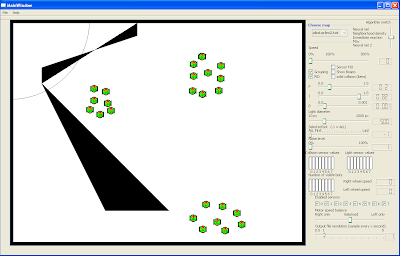1. Robot: Physics-based model. Instead of using unicycle or point mass robot model, we developed a physics-based model that illustrates how the real robots act in the environment. Furthermore, we developed a sensor model for infrared beam to ensure that the robot can only communicate with other robots and detect objects if they are within their sensing and communication beam. This model is much more realistic to the robot design than many existing sensor models.
2. Control: Adaptive PID control. The control is developed to clarify how we control the real robots using adaptive PID control. This control can be selectively applied or not.
3. Swarming algorithms: 3 branches of swarm algorithms developed for simulation
a) Directional signal based swarm: The algorithm is based on directional signal. Using the algorithm, a robot will react to the first signal it perceives.
b) Signal intensity based swarm: The algorithm is based on signal intensity. Applying this algorithm, a robot will react to the signal intensity of its neighbours. There are two versions developed in the platform
c) Neural network based swarm: The algorithm is based on a signal processing of sensory inputs using a neural network. There are two versions developed in the platform

Here is the screenshot of this software platform.
A brief desciption of the functions of this platform:
- Number of robots can be added unlimitedly
- Five different algorithms are switched online
- The scenario can be pre-arranged with a set of user-defined obstacles
- The speed of robots can be online adjusted at all or on individual robots
- Functions of grouping and PID control can be online selected
- Kp, Ki, Kd of PID can be adjustable online
- Sensor beam of all robots or individual can be show on or off
- Noise to sensory reading is adjustable.
- Values of each sensor on the robots are visible
- Number of neighbouring robots are realtime checked and visibly shown.
- The sensor beam can be activated or disactivated online.
- The speed balance of diffirential motors are adjustable.
- Light source diameter is adjustable and blind pot between robots under light conditions are implemented
- Output of simulation in terms of robots' position and orientation are saved in plain text for post-process
The first video clip of our simulation platform (consisting of a only)
The second video clip of our simulation platform (consisting of a,b,c)


No comments:
Post a Comment